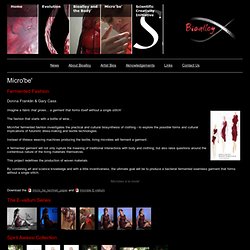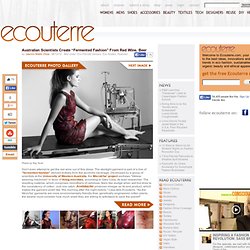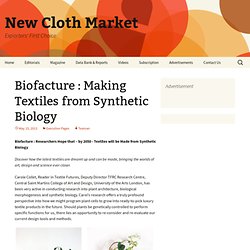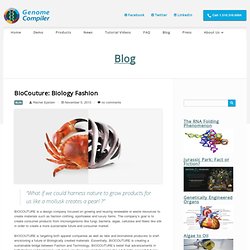

Planteamiento. Micro'be' Fermented Fashion Donna Franklin & Gary Cass Imagine a fabric that grows... a garment that forms itself without a single stitch!

The fashion that starts with a bottle of wine... Micro'be' fermented fashion investigates the practical and cultural biosynthesis of clothing - to explore the possible forms and cultural implications of futuristic dress-making and textile technologies. Instead of lifeless weaving machines producing the textile, living microbes will ferment a garment. A fermented garment will not only rupture the meaning of traditional interactions with body and clothing; but also raise questions around the contentious nature of the living materials themselves. This project redefines the production of woven materials.
By combining art and science knowledge and with a little inventiveness, the ultimate goal will be to produce a bacterial fermented seamless garment that forms without a single stitch. 'Microbes à la mode' Download the. Australian Scientists Create "Fermented Fashion" From Red Wine, Beer. Cass and his colleagues culture the Acetobacter in vats of red wine—”cheap Aussie ‘goon’ wine, not the good stuff that is kept for us,” he says—but any kind of vino is copacetic.

The fabric takes on the color of its feedstock: red for red wine, translucent for white wine or beer. The bacteria ferments the alcohol into a raft of microbial fibrils that float just above the surface. Once extracted, the two-dimensional sheets are fashioned into clothing or fitted seamlessly on a person’s body to create a second skin. But the boozy textile isn’t just a conversation starter. Cass is researching Microb’be’s potential as medical dressing or scaffolds for tissue engineering .
“Fermented fashion doesn’t need to stay within the fashion world but can inspire new thoughts in many other disciplines, such as medicine, engineering, dentistry, architecture,” he says. We’ll drink to that.
About - Synthetic Aesthetics. What is Synthetic Aesthetics?

Synthetic Aesthetics is an experimental, international research project between synthetic biology, art, design and social science, funded by the NSF and EPSRC. Run by the University of Edinburgh, Scotland, and Stanford University, California, the project team comprises bioengineers Drew Endy (Stanford) and Alistair Elfick (Edinburgh), and social scientists Jane Calvert (Edinburgh) and Pablo Schyfter (Edinburgh), and designer/artist Alexandra Daisy Ginsberg. The project is explored in our book published by The MIT Press in 2014. Amy Congdon's "Biological Atelier" Explores Lab-Grown Textiles.
Share on Tumblr Email Congdon specializes in digital embroidery, a technique used to manufacture textile-based surgical implants. After researching burgeoning technologies such as bio-inkjet printing , which uses an inkjet device to print “bio-ink” patterns for growing biological tissue, her interest was piqued. “At some point in the not-too-distant future, biotechnology is going to give the design world the biggest set of completely new materials and tools it has ever had the opportunity to play with,” she says. And with networks such as DIYbio and BioBricks to support growing amateur-biology literacy, that future could even be tomorrow. With Congdon’s “biological atelier,” she imagines a workshop, circa 2082, where couture is fashioned not from fabric but from cells.
But first, she has to work within the constraints of 2011 technology: producing embroidery scaffolds on which cell lines can grow. Amy Congdon. Biofacture : Making Textiles from Synthetic Biology. Biofacture : Researchers Hope that – by 2050 - Textiles will be Made from Synthetic Biology Discover how the latest textiles are dreamt up and can be made, bringing the worlds of art, design and science ever closer.

Carole Collet, Reader in Textile Futures, Deputy Director TFRC Research Centre, Central Saint Martins College of Art and Design, University of the Arts London, has been very active in conducting research into plant architecture, biological morphogenesis and synthetic biology. Carol’s research offers a truly profound perspective into how we might program plant cells to grow into ready-to-pick luxury textile products in the future.
Should plants be genetically controlled to perform specific functions for us, there lies an opportunity to re-consider and re-evaluate our current design tools and methods. Left : Gold Nano Spinach (Spinacia Aurea Electrica) Produces bio nano transistors for the electronic sector, and multi-mineral food supplements, a 2050 design scenario. BIOCOUTURE. BioCouture: Biology Fashion - Genome Compiler Corporation. “What if we could harness nature to grow products for us like a mollusk creates a pearl ?”

BIOCOUTURE is a design company focused on growing and reusing renewable or waste resources to create materials such as fashion clothing, sportswear and luxury items. The company’s goal is to create consumer products from microorganisms like fungi, bacteria, algae, cellulose and fibers like silk in order to create a more sustainable future and consumer market. BIOCOUTURE is targeting both apparel companies as well as labs and biomaterial producers to start envisioning a future of Biologically created materials.
Essentially, BIOCOUTURE is creating a sustainable bridge between Fashion and Technology. BIOCOUTURE’s belief that advancements in both fashion and technology will make way for a new market seems like a futuristic concept but one that seems to be highly achievable at the same time. Crabs into bike helmets?! Suzanne Lee: Grow your own clothes.
Investigación textil: Moda hecha a base de fibras de leche.